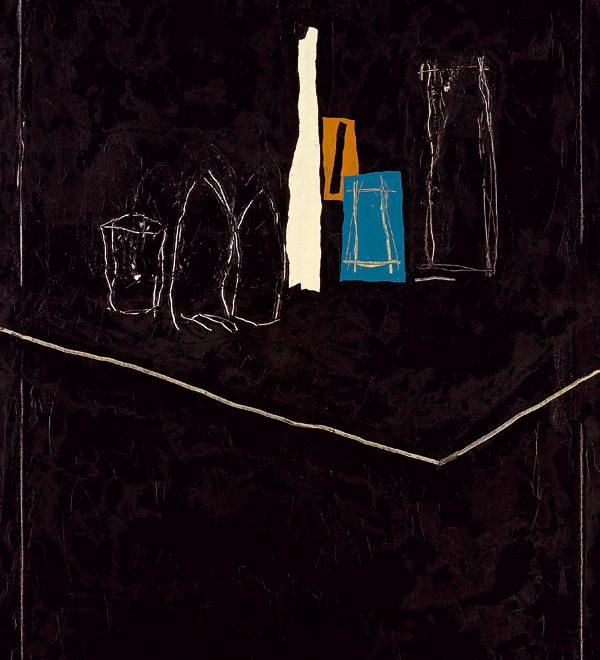Alberto Corazón
Conceptual work, paiting & sculpture
The retrospective that the IVAM dedicates to Alberto Corazón takes a look at his production from the seventies until today, offering the public eighty-four of his paintings, sculptures and conceptual works. In spite of being considered a pioneer artist of Spanish Conceptual art, this series of his works is not very well known, for his experimental and renovating contributions to our art have never been exhibited again. Corazón combined his artistic production with his work, first as a graphic artist, and later as an industrial artist, and he was undoubtedly one of the most innovative and important personalities in this field in our country. The transference of theoretical ideas and formal resources from design to creative activity was a permanent feature of his production, characterised by self-reflection and the integration of interdisciplinary knowledge. The dematerialised practice that Alberto Corazón developed in the first half of the seventies, coinciding with what was broadly known as Spanish Conceptual art or, perhaps more precisely, new artistic behaviours in the scope of the post-avant-garde, is linked to the profusion of images produced by the emerging communication society, based on the new opportunities of mechanical reproduction and mass consumerism. Corazón worked with iconographic repertoires taken from the mass media, which he refashioned by means of a unique expressive vocabulary in the laboratory –accentuating wefts and lines, underscoring positive-negative contrasts, integrating text and photography– while conceptualising the visual contents, based on the theory provided by semiological studies and communication and information theory. He was motivated by a double objective: on the one hand, to recognise the avalanche of images published in the press as an event of a determinant period for art; and, on the other, to relate both plastic linguistic ruptures and critical decoding with the need to maintain a new relationship with those ordinary, banal, anonymous and poor-quality images. His projects Leer la imagen (Reading the Image) and Documentos (Documents), represented in the exhibition by sixteen pieces, including La paloma. “Homenaje a Picasso” ((The Dove. Homage to Picasso, 1972); Iconografías banales (Banal Iconographies, 1972); Propuesta para la formalización de una iconografía popular (Proposal for the Formalisation of a Popular Iconography, 1973); Aire, fuego, tierra, aire (Air, Fire, Earth, Air, 1972); Academia nocturna (Night Academy, 1972); Piraña (Piranha, 1974); La mujer (The Woman, 1975); and Una iconografía de clase (A Class Iconography, 1972), indispensable in order to understand the new artistic expressions in the pre-democratic years in our country, channel this singular sensibility within the panorama of Spanish Conceptualism. Corazón’s contribution to Spanish culture, which attempted to arouse resistance and democratic sensibility during the dictatorship, was not limited to the field of art but included publications and the production and diffusion of knowledge connected with the new practices. In this sense, Ciencia Nueva and Alberto Corazón Editor-Comunicación represent two collective contributions of undeniable value promoted by the Madrid artist and designer with the intention of helping construct an open, modern, democratic society. In his graphic pieces, really unique at the time, he applied linguistic formulas from his conceptual investigations, while the editorial line of his publications addressed progressive humanistic, social and political issues previously unheard of in Spain. The eighties bring about a parenthesis in the creative production of the artist, who closes the crisis of Conceptual art by returning to his work as a designer, evolving from graphic design to corporative identity and industrial design, under the auspices of the new possibilities, necessities and commissions arising from democratic renovation. In 1992, Corazón appeared once again on the art scene with a private exhibition, Estrategias de agrimensor (A Surveyor’s Strategies), comprising mainly sculptures –twelve of which are included in this exhibition– but also paintings, which respond to a grammar constructed on a formally refined, ritual and symbolic objectualism. This gave way to emblematic, Expressionist-inspired painting, based on primitive sketchy lines of drawing, addressing mysterious narrations or pictorial research performed by the master in his studio, represented in this exhibition by fundamental pieces like Retablo del nómada (The Nomad’s Altarpiece, 1992), Caída en el silencio II (Fall into Silence II), 1995), Vigilia del muchacho que va a ser herido (Wakefulness of the Boy who is about to be Wounded, 1995) or Estrategias para recordar los sueños (Strategies for Remembering Dreams, 1996). As well as a series of paintings about nature produced in 2002 and the following years –hives, solstices, mineral wharfs, storms…, of which twenty works will be shown in this exhibition– he has carried out prolonged research into the still life genre, which he still continues working on today, and twenty of these pieces are included in the exhibition. Alberto Corazón reflects about the relationship between drawing and colour, representation and archetype, eidetic construction and retinal formulas. He continues with his ideas about perception and iconography, and at the same time, within the framework of cultured painting, he addresses compositional problems closely linked to the iconic identity of the genre and its understanding. His latest still lifes, amply represented in the exhibition, embody a painting based on chromatic effusiveness, objectuality and freedom in the arrangement of figures. Mediterranean and hedonistic, this most recent work alludes to the creation of a strictly pictorial space, proper of real painting, tinged with touches of innocence and happiness. In the paintings made in 2007, the flexibility with which the icons are outlined and their chromatic and formal relationships are articulated offers a horizon of evolution where the reinvented still life melds with landscape constructions, born on a fluid and porous frontier where the force of the hybridisations challenges the stereotypes of the images and the sedentarism of the vision.



